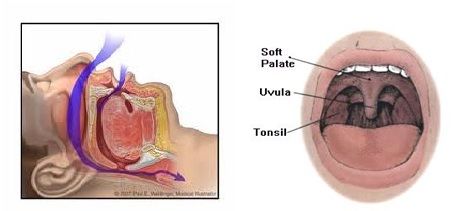Snoring is caused by vibration of the soft palate (the soft part of the mouth’s roof) as the lungs strain to inhale oxygen through obstructed airways.
Causes
- Poor nasal airflow
- Loose tissues in the throat
- Loose tissues in the roof of mouth – soft palate
- Large tonsils and adenoids
- A large or mispositioned tongue
- Abnormalities in the jaw
- Excess neck fat
Major signs and symptoms of sleep apnea
- Loud and chronic snoring
- Choking, snorting, or gasping during sleep
- Long pauses in breathing
- Daytime sleepiness, no matter how much time you spend in bed
- Waking up with a dry mouth or a sore throat
- Morning headaches
- Restless or fitful sleep
- Insomnia or nighttime awakenings
- Going to the bathroom frequently during the night
- Waking up feeling out of breath
- Forgetfulness and difficulty concentrating
- Moodiness, irritability, or depression
Nasal blockage can be caused by a twist in the nasal septum cartilage. Other nasal problems include swelling of the nasal tissues due to allergy or polyps. If a nasal blockage is part of your snoring problem, this will be your first operation.
Nasal Surgery options for snoring
Radio-frequency Cauterization of Inferior turbinates
Radio-frequency energy can be used to shrink the turbinates by creating scar tissue in them which results in a more open nasal passage. The procedure takes about 15 minutes. Most of that time is spent anaesthetizing the nasal tissue with topical and other anaesthetics injected into the area.
Multiple applications are done on each side of the nose for maximal effect. After the scar tissue is formed, which takes about 3 months; one can notice the full effect of the procedure. The scar tissue will soften over time and the swelling and narrowing may recur. If needed, the procedure can be repeated.
Deviated septum
The septum deviation can be corrected by removing the crooked cartilage. This surgery usually is performed in the operating room under general anaesthesia. After surgery, if the nasal obstruction is improved, the snoring often improves.
Nasal polyps
If the polyps are large enough, they will require surgery to remove them. This is done in an operating room under general anaesthesia. Removing the polyps reduces nasal obstruction, which may improve snoring.
Tonsils and Adenoids
If tonsils and adenoids are enlarged, infected; they could be the cause of snoring in children. Removing the adenoids and tonsils reduces snoring problems especially in children.
Uvulectomy
Uvulectomy is the removal of the uvula. This can easily be performed under local anaesthesia. A person usually does not miss having the uvula. Most people describe the pain as similar to a bad viral sore throat that is worse when swallowing. The main risks of uvulectomy are pain, bleeding, and altered speech.
Laser-assisted uvulopalatoplasty (LAUP)
Laser-assisted uvulopalatoplasty (LAUP) involves trimming the palate with a laser. It can be performed under local anaesthesia. Several procedures are usually needed for a maximal effect. The scarring caused by the procedure stiffens the palate, decreasing the ability of the palate to vibrate and pulls the palate sideways to tighten it. The palate can be stiffened by creating scar tissue (as discussed previously) or with implants.
Radio-frequency ablation of the palate
Radio-frequency ablation of the palate can be performed under local anaesthesia. The tissue heals as scar tissue, and the palate becomes stiffer and vibrates less. Generally, scar tissue in the palate continues to form for up to three months. Up to 77% of people report reduced snoring after this procedure, however, as the tissue continues to heal over time, the palate may soften and re-obstruct.
Palate implants
Palate implants are now being used to treat snoring. They are made from Dacron, which is a non-reactive material that has been used for many years for heart valve surgery and hernia repair. Dacron also encourages the normal tissue to grow into it. Small Dacron implants are placed into the palate under local anaesthesia. The implants stiffen the palate like scar tissue after radiofrequency treatments. The implants stay in the tissue, so recurrence of snoring should be reduced.



